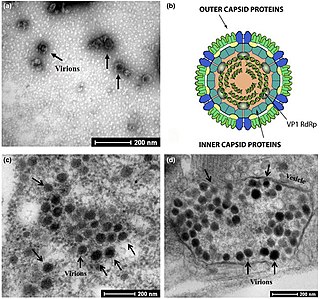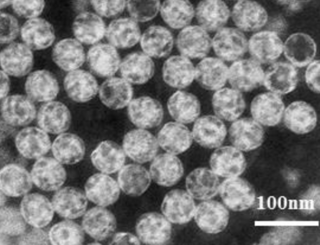
Reoviridae is a family of double-stranded RNA viruses. Member viruses have a wide host range, including vertebrates, invertebrates, plants, protists and fungi. They lack lipid envelopes and package their segmented genome within multi-layered capsids. Lack of a lipid envelope has allowed three-dimensional structures of these large complex viruses to be obtained, revealing a structural and likely evolutionary relationship to the cystovirus family of bacteriophage. There are currently 97 species in this family, divided among 15 genera in two subfamilies. Reoviruses can affect the gastrointestinal system and respiratory tract. The name "reo-" is an acronym for "respiratory enteric orphan" viruses. The term "orphan virus" refers to the fact that some of these viruses have been observed not associated with any known disease. Even though viruses in the family Reoviridae have more recently been identified with various diseases, the original name is still used.

Totiviridae is a family of double-stranded RNA viruses. Giardia lamblia, leishmania, trichomonas vaginalis, and fungi serve as natural hosts. The name of the group derives from Latin toti which means undivided or whole. There are 28 species in this family, assigned to 5 genera.

Nodaviridae is a family of nonenveloped positive-strand RNA viruses. Vertebrates and invertebrates serve as natural hosts. Diseases associated with this family include: viral encephalopathy and retinopathy in fish. There are nine species in the family, assigned to two genera.

Orthoreovirus is a genus of viruses, in the family Reoviridae, in the subfamily Spinareovirinae. Vertebrates serve as natural hosts. There are ten species in this genus. Diseases associated with this genus include mild upper respiratory tract disease, gastroenteritis, and biliary atresia. Mammalian orthoreovirus 3 induces cell death preferentially in transformed cells and therefore displays inherent oncolytic properties.

Totivirus is a genus of double-stranded RNA viruses in the family Totiviridae. Fungi serve as natural hosts. The name of the group derives from Latin toti which means undivided or whole. There are seven species in this genus.

Alphachrysovirus is a genus of double-stranded RNA viruses. It is one of two genera in the family Chrysoviridae. They infect fungi, in particular Penicillium. Their name is derived from the Greek word chrysos which means yellow-green. There are 20 species in this genus.

Fijivirus is a genus of double-stranded RNA viruses in the family Reoviridae and subfamily Spinareovirinae. Plants serve as natural hosts. Diseases associated with this genus include: galls (tumours) in infected plants and Fiji disease, with severe stunting, deformation and death. The group name derives from Fiji island the place where the first virus was isolated. There are nine species in this genus.

Double-stranded RNA viruses are a polyphyletic group of viruses that have double-stranded genomes made of ribonucleic acid. The double-stranded genome is used to transcribe a positive-strand RNA by the viral RNA-dependent RNA polymerase (RdRp). The positive-strand RNA may be used as messenger RNA (mRNA) which can be translated into viral proteins by the host cell's ribosomes. The positive-strand RNA can also be replicated by the RdRp to create a new double-stranded viral genome.

Phytoreovirus is a genus of viruses, in the family Reoviridae, in the subfamily Sedoreovirinae. They are non-turreted reoviruses that are major agricultural pathogens, particularly in Asia. Oryza sativa for RDV and RGDV, dicotyledonous for WTV, and leafhoppers serve as natural hosts. There are three species in this genus. Diseases associated with this genus include: WTV: galls (tumor). RDV: dwarf disease of rice. RGDV: dwarfing, stunting, and galls.
Ipomovirus is a genus of positive-strand RNA viruses in the family Potyviridae. Member viruses infect plants and are transmitted by whiteflies. The name of the genus is derived from Ipomoea – the generic name of sweet potato. There are seven species in this genus.
Aquabirnavirus is a genus of viruses, in the family Birnaviridae. Salmonid fish serve as natural hosts. There are three species in this genus. A disease associated with this genus, Infectious pancreatic necrosis (IPN) in salmonid fish, causes significant losses to the aquaculture industry. Chronic infection in adults, and acute viral disease in young salmonid fish can occur.

Aquareovirus is a genus of double-stranded RNA viruses in the family Reoviridae and subfamily Spinareovirinae. Fish, shellfish, and crustacean species serve as natural hosts. Aquareoviruses in general have low or no pathogenicity for fish. However, some cause hemorrhagic disease, hepatitis and pancreatitis. Grass carp hemorrhage virus is the most pathogenic aquareovirus. There are seven species in this genus.
Idnoreovirus is a genus of double-stranded RNA viruses in the family Reoviridae and subfamily Spinareovirinae. Hymenoptera insects serve as natural hosts. The genus name is an acronym for insect derived non occluded reovirus. There are five species in this genus.

Mycoreovirus is a genus of double-stranded RNA viruses in the family Reoviridae and subfamily Spinareovirinae. Fungi serve as natural hosts. Diseases associated with this genus include: hypovirulence of the fungal host. The name of the group derives from Ancient Greek myco which means fungus. There are three species in this genus.
Oryzavirus is a genus of double-stranded RNA viruses in the family Reoviridae and subfamily Spinareovirinae. Member viruses infect plants and are transmitted by planthoppers. Diseases associated with this genus include: rice stunting, enations on veins of leaves and leaf sheaths, ragged leaves, and flower suppression. There are two species in this genus.

Quadriviridae is a family of double-stranded RNA viruses with a single genus Quadrivirus. The fungi Rosellinia necatrix serves as a natural host. The name of the group derives from the quadripartite genome of its members where in Latin quad means four. There is only one species in this family: Rosellinia necatrix quadrivirus 1.
Cardoreovirus is a genus of double-stranded RNA viruses in the family Reoviridae and subfamily Sedoreovirinae. Crabs serve as natural hosts. There is only one species in this genus: Eriocheir sinensis reovirus. Diseases associated with this genus include: trembling disease. The name derives from Latin words "carcinus" which means crab and "doeca" which means twelve in reference to the number genome segments.

Dinovernavirus is a genus of double-stranded RNA viruses in the family Reoviridae and subfamily Spinareovirinae. Member viruses replicate in a variety of mosquito cell lines. The name is an abbreviation for double-stranded, insect, novem, rna virus. There is one species in the genus: Aedes pseudoscutellaris reovirus.
Mimoreovirus is a genus of viruses, in the family Reoviridae, in the subfamily Sedoreovirinae. The only isolate infects the marine photosynthetic protist Micromonas pusilla, a prasinophyte. There is only one species in this genus: Micromonas pusilla reovirus.
Mammalian orthoreovirus (MRV) is a double-stranded RNA virus. It is a part of the family Reoviridae, as well as the subfamily Spinareovirinae. As seen in the name, the Mammalian Ortheoreovirus infects numerous mammalian species and vertebrates which serve as natural hosts. Some diseases that occur as a result of this virus or are associated with this virus include mild upper respiratory illness, and gastrointestinal illness. Examples of these are: upper respiratory tract syndromes, gastroenteritis, biliary atresia, obstructive hydrocephalus, jaundice, alopecia, conjunctivitis, and ‘oily hair’ associated with steatorrhea.















